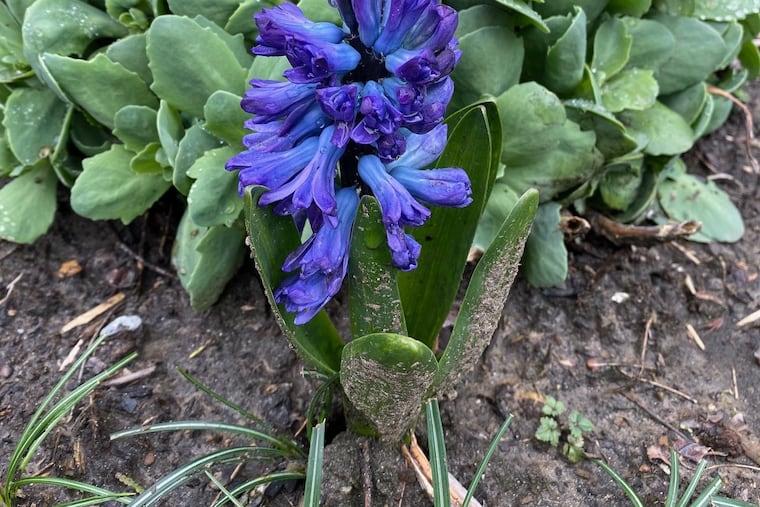Lawn and garden work you can start on in spring in the Philly region
Move your plants, divide big perennials and other lawn and garden work you can do in spring.

Even though it’s only spring, there’s plenty to do in the garden, experts say, and a little work now will pay off down the road.
We talked to some garden pros, who offer these 10 tips about gardening in early spring in the Philly region:
Now’s the time to move some plants
Now is really the best time to move certain perennials, said Andrew Bunting of the Pennsylvania Horticultural Society. “Many of them are just emerging, so rearranging them now in the garden puts very little stress on the plants.” Summer or fall-flowering perennials should do well, like bee balm, sedum, or hyssop.
What shouldn’t you move? Hold off on spring flowering plants like peony, said Erin Kinley, who administers the Master Gardener program for the Penn State University Agricultural Extension in our region.
Help make this guide better
Divide big perennials
Bunting said that if you’ve got a healthy mound of a perennial that needs a little more room, spring is a good time to divide the plant and give it more space.
“Also, with bee balm and other clump-forming perennials ... you can dig them up and divide into multiple plants and move around the garden,” he said.
Prune early blooming shrubs
“In general, for many plants pruning after blooming is a good rule of thumb,” Bunting said. “For something like an azalea, it gives the shrub a chance to grow and recover and in many cases set new flower buds for the following year.”
He recommends spring pruning of shrubs that flower on current season’s “wood.” Examples include panicle hydrangea, Hydrangea paniculata; smooth hydrangea, Hydrangea arborescens; and blue spirea, Caryopteris x clandonensis. Bunting said shrubs with colorful winter stems can be cut back now too, like the red- and yellow-stemmed dogwoods, Cornus sericea, Cornus alba, and Cornus sanguinea.
Weed
Randy Orner, of Orner’s Garden Center in Havertown, said the mild winter gave weeds a head start. Now is a good time to get into your flower beds and get ahead of the coming onslaught. You need to do it soon before the weeds start to seed themselves. Kinley said the Agricultural Extension wants gardeners in our region to be especially aggressive in getting rid of lesser Celandine, an invasive species that’s spreading in Southeast Pennsylvania.
Spruce up that window box or planter
“If you have access to some early spring annuals like pansies and primula or ornamental vegetables like purple lettuce and Swiss chard, then you can use those in spring containers and window boxes,” Bunting said. Most big-box stores’ garden centers are open — local nurseries on a case-by-case basis. Check with your local plant retailer.
Aerate your lawn
Orner said now is an ideal time to aerate your lawn — punching holes in the ground so that oxygen can reach the roots.
A lawn service can do this, or you can rent a gas-powered core aerator from a hardware store, but be advised the machines are a beast to handle. It often makes sense to joint-venture with neighbors to share the expense and equipment. If you have a small lawn and a strong back, you can also use a handheld core aerator. You want the kind that creates a plug (pictured above), so you are not compacting the soil.
Seed and feed your lawn.
Orner also said it’s a good time to put down grass seed on bare patches, and some early-season starter fertilizer to go with it. Don’t use weed-and-feed products, he said, as that will impede new growth. Wait until at least mid-May for weed control, he said, when the lawn weeds (if you have them) really start to get going. Kinley advises going easy on spring fertilizer — it’s easy to overfertilize, she said, and fall is the best time.
Fight the spotted lanternfly
Kinley said all gardeners can do their part to help the state’s $18 billion agricultural industry by keeping an eye out for signs of the invasive spotted lanternfly. It’s hit our region in a big way, and at this time of year you can spot the egg mass on tree branches. Here’s one that Kinley saw in early 2020 at Temple’s Ambler campus.
If you see one, use an old credit card to scrape it into a zipper-lock plastic bag, and toss the whole thing. You can also report the sighting to the Agricultural Extension.
When in doubt, ask an expert — it’s free
Kinley reports that Penn State Extension Master Gardener hotlines are open. They’re free, she said, and can assist you with plant identification, indoor and outdoor pest identification and management, soil test information, fertilization, plant selection for specific sites, invasive plants, and both organic and conventional gardening methods. Most hotlines are using email right now, she said, but some are still able to take phone calls. Learn more about how to contact yours by choosing your county from this list here and clicking on their Garden Hotline tab.
» READ MORE: Our best Philly tips: Read our most useful stories
This article has been updated since it first published.